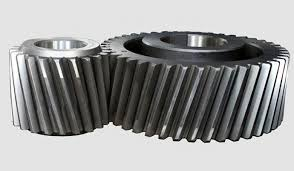The Beauty of Precision: How Engineering Powers Cosmetic Production

Enter any shop and you will see the shelves full of perfectly packaged lipsticks, serums and compacts, all identical, beautiful, and carefully molded. But have you ever stopped to think about what makes this visual and tactile perfection a reality? Charts of precision engineering lie behind every smooth container and symmetrical applicator.
From helical gears that drive smooth, synchronized movement in machinery to cosmetic mold accessories that shape and perfect the final product, the beauty industry is deeply intertwined with manufacturing technology. Although the final product can be glamorous, the process is based on mechanical excellence, material science and micro-engineering.
The article discusses the amazing connection between the industrial parts and the cosmetics we apply daily in our lives and indicates that behind every product there is a world of accuracy, efficiency and innovation.
Helical Gears: Smooth Motion Behind High-Precision Machinery
Helical gear systems are central to the seamless function of automated production lines. Unlike spur gears that transmit power with abrupt contact, helical gears feature teeth that are cut at an angle. This inclined shape enables progressive engagement of the teeth which makes motion transmission much smoother, quieter and efficient.
In cosmetic manufacturing, where speed, precision, and consistency are vital, helical gears play a foundational role. Whether you are moving conveyor belts, operating an injection molding machine or rotating robotic arms, these gears are able to provide high load capacity with less vibration; which is critical in handling delicate packaging applications.
Helical gears are especially valued for their durability and precision. They have the capability to keep lined up when under stress guaranteeing that each tube of lipstick, bottle of foundation or jar of cream is made to precise requirements. Any variation may lead to misalignment, imperfection, or spillage none of which is admissible in the high-end cosmetics industry.
Moreover, the gears enable faster rotation thus enhancing the overall efficiency of high-volume manufacturing settings. By enabling quiet, continuous operation, helical gears help minimize wear on machinery, reducing downtime and maintenance costs.
The Role of Cosmetic Mold Accessories in Shaping Consistency and Quality:
If gears provide motion, cosmetic mold accessories provide the shape. These are custom parts that are at the core of molding systems that create everything including small cases, mascara wands and lip gloss containers. They serve to ensure homogeneity, functionality, and aesthetic value of the end product.
Mold accessories consist of ejector pins, nozzles, guide pillars, sprue bushings, core inserts and cooling systems. Each has its own role in making sure that the molten material is accurately poured into the mold, solidifies effectively, and is deformed-free after ejection.
- Ejector systems push finished parts out of the mold without damaging delicate features.
- Cooling channels regulate the mold’s temperature to prevent warping and reduce cycle time.
- Core pins and inserts help create hollow or complex shapes like applicator tips and lotion pumps.
With cosmetic manufacturing, no matter how minute the flaw (a seam, a bubble, or a misalignment) the product is no longer saleable. That’s why cosmetic mold accessories are precision-machined to extremely tight tolerances. This will ensure that all the products are not only functional as expected but also of high industry standards of aesthetics.
Additionally, as people give more concern to sustainable packaging, manufacturers are adopting mold accessories that are intended to work with bio-based plastics or recyclable materials. Such developments demand accessories that can accommodate emerging thermal characteristics and flow features- testing the limits of conventional mold design.
When Mechanics Meet Aesthetics: Synchronizing Gears and Molds in Mass Production
To make a cosmetic product alive, it is not only important to have quality gears or precision molds; there must be coordination between mechanical and molding systems. This combination is what achieves real mass production without making any sacrifice to design or functionality.
For example, an automated line producing foundation bottles relies on helical gears to coordinate the movement of each station: mold closure, material injection, cooling, ejection, inspection, and assembly. Such steps should occur at specific timings. A mishap at one point, e.g. a poorly ejected component, may cause the whole line to stop.
Here, the interaction between helical gear mechanisms and cosmetic mold accessories becomes critical. The gears make the movement continuous and in sync, whereas the mold parts deal with shaping and handling of the product.
This coordination is even useful in the post-molding process such as labeling and capping. Gears turn platforms, robot arms, and align pieces ready to be assembled, all in perfect time with the production of the molding phase. This is particularly relevant in the fields of cosmetics, where several packaging elements (tube, cap, applicator) have to be perfectly compatible.
Production speed is not the only outcome of this harmony, brand consistency is also a result. The consumers are used to seeing their lipsticks or compacts in Tokyo and New York to look the same. That consistency on the large scale is only possible by engineering synergy between mechanical motion and precise shaping tools.
Micro-Engineering for Macro Beauty: Challenges and Innovations
The cosmetic industry is ever changing and so are the engineering issues involved in it. There is increased pressure on consumers to have more variety, quicker innovation, and sustainable solutions, all of which should be of high quality and appearance. These demands need advanced micro-engineering to be met.
Automation and real-time quality control represent one of the key trends. Intelligent sensors built into gear-driven systems can be used to notice when temperature, pressure or cycle time falls out of kilter, and parameters can be changed on the fly. This minimizes waste and makes every product to be in specifications by the time it goes to inspection.
Another innovation is rapid tooling. The classic mold accessories might have taken weeks to produce. With CNC machining or additive manufacturing, a company can now manufacture new accessories in days–allowing quicker prototyping, and responding to market trends.
Also, the complexity of cosmetic packaging increases, say, to a two-compartment jar or an integrated applicator, then the mold component design should be changed. These are multi-cavity molds, collapsible cores, and elaborate cooling channels which enable complex, multi-purpose designs without compromising on efficiency.
Conclusion:
When we mention cosmetics, what comes to our mind is beauty, glamour or personal care. We seldom think of the engineering wonders that are behind such products. However, in reality, all compacts, mascaras or serums are the products of well-calculated ingredients operating in the shadows.
Helical gears ensure smooth, consistent production movement. Cosmetic mold accessories give each product its flawless shape and finish. They combine to compose the spine of a manufacturing system that is predicated on accuracy, velocity and innovation.
With the ever-increasing consumer demands and the complexity of products, the role of engineering in the beauty industry can only grow more essential. It is the evidence of the fact that precision and performance are never outdated even in the world of luxury and aesthetics.




